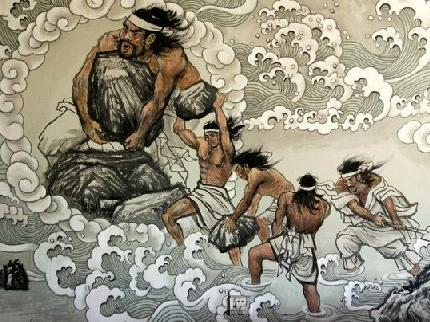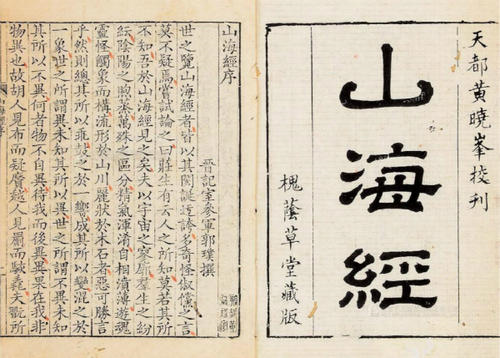Event Overview

Father Jiu Yu heals water
Father Jiu Yu heals water is an ancient mythological tale from China, derived from the famous ancient legend of the Great Flood. During the time of the Three Emperors and Five Emperors, the Yellow River was flooded. As descendants of the Yellow Emperor, father and son Jiu and Yu were appointed by the two emperors Tang Yao and Yu Shun to be the Shonbo and Xia Bo respectively, responsible for water control.
Source

The Mountain and Sea Sutra
Shan Hai Jing – Hai Nei Jing (Mountain and Sea Classic) – Hai Jing – Hai Nei Nan Jing, Volume 18. Shanhaijing is the first large geographic work describing mountains, rivers, products, customs and folklore in China, and the first large compilation of myths and legends in ancient China. The book consists of eighteen books, divided into two parts: “Mountain Sutra” and “Sea Sutra”. The “Mountain Sutra” is the “Five Tibetan Mountain Sutra”; the “Sea Sutra” includes four “Overseas Sutra”, four “Sea Inner Sutra”, four “Great Wilderness Sutra” and another “Sea Inner Sutra”. It describes the mountains and rivers in various places as an outline, and records many local myths and legends. Among them, the myths and legends such as “Jingwei Reclamation”, “Quafu Chasing the Sun”, “Houyi Shooting the Sun”, “Jiu Yu Healing the Water” and “Huang Di Catching Chi You” reflect the heroic spirit of the Chinese nation.
Shanhaijing” a total of 18 volumes, including “Mountain Classic” 5 volumes, “Sea Classic” 13 volumes, the age of each volume of writings can not be determined, of which 14 volumes for the [Warring States period works, 4 volumes for the early years of the Western Han Dynasty works. The content of Shanhaijing is mainly geographical knowledge from folklore, including mountains and rivers, dao li, ethnic groups, products, medicines, rituals, witch doctors, and so on. Many popular ancient myths, legends and fables are preserved, including Kwafu chasing the sun, Nuwa mending the sky, Jingwei reclamation, and Dayu healing the water. The Shanhaijing has extraordinary documentary value and is a reference for the study of ancient Chinese history, geography, culture, Chinese and foreign transportation, folklore and mythology, etc. The mineral records in it are the earliest documents about it in the world.
The version of “Shanhaijing” is complicated, and the earliest version now visible is Jin Guo Pu’s “Biography of Shanhaijing”. However, the title of “Shanhaijing” is mentioned in the “Historical Records”, and the earliest collection of books is “Hanshu – Yiwenzhi”. As for its real author, some former people think it is Yu, Bo Yi, by the Western Han Dynasty Liu Xiang, Liu Xin edited, before forming a heirloom book, now more believe that the specific date of the book and the author has no way to confirm. The “Shanhaijing” has been very influential and has received much attention from the international sinology community, and scholars of ancient and modern times have different perceptions of its content, such as Sima Qian, who bluntly stated that “I dare not speak of its content”, and Lu Xun, who believed that it was “a book of wizards and magicians”. Therefore, “Shanhaijing” is a valuable early geographic work.
The Shanhaijing is a book of ancient Chinese mythology, geography, plants, animals, minerals, products, witchcraft, religion, medicine, folklore, and ethnicity, reflecting a wide range of cultural phenomena. In addition to preserving a wealth of mythological information, it also covers a variety of academic fields, such as philosophy, aesthetics, religion, history, geography, astronomy, meteorology, medicine, animals, plants, minerals, folklore, ethnology, geology, oceanography, psychology, anthropology, and so on, which can be described as vast and vast, like a sea sun. In ancient times, when culture, technology and transportation were not developed, the Shanhaijing was the most documented mythological book in China and an encyclopedia of geographical knowledge.
The significance of Father Yu’s healing of water
In the face of the great flood, Dayu learned from the failure of Father Jiu’s flood control and changed the “blocking” method to lead the people to divert the flood, demonstrating his wisdom to lead the people to overcome the difficulties; in order to control the flood, Dayu fought with the people for years, putting aside his personal interests, and once In order to control the floods, Dayu fought with the people for many years, putting aside his personal interests, and “passed through his house three times without entering”. Dayu spent 13 years of his life and physical strength to finally complete the great task of water control.
When Yu succeeded in controlling the floods, the world revered him as a god, honoring him as “Dayu” and “Shen Yu” and naming him on a par with heaven and earth, so to speak, as Heaven, Earth, and Yu. At that time, people even called the whole China “Yu domain”, meaning the place where Dayu had governed, and thus put all their good wishes on Dayu to control rivers and overcome floods. He “opened up nine states, opened up nine channels, paved nine rivers and nine mountains,” and became an all-powerful god of heaven.
The Shi Jing praises, “The floods were vast, and Yu laid down the earth.”
The Shangshu says, “Yu pacified the waters and the earth, and the Lord named the mountains and rivers.” The Zuo Zhuan (Zuo Zhuan) says: “Beautiful Yu Kung! Mingde is far away. The book of Zuo Zhuan says, “Yu is a great man, and his virtue is far away.” The Records of the Grand Historian also says: “Great Yu pacified water and soil, and his merits were equal to those of heaven and earth.”
(see also “The Book of History”)
From Gilgamesh to Noah’s Ark, the Great Flood is a common component of ancient legends of many peoples around the world. Father Jiu Yu’s healing of water is the Chinese version of the flood legend, and the entire process of healing changed the pattern of civilization in the middle and lower reaches of the Yellow River, providing the opportunity and conditions for China to enter national civilization. Around the 24th to 22nd centuries B.C., the climate in the northern hemisphere cooled considerably. Documents record that when Shun sent Yu to invade the three Miao, “there were ice …… changes in the grains in summer” and the climate was abnormal. At the turn of the 22nd and 21st centuries before, the climate changed abruptly and generally turned warmer, and nomadic civilization gradually shifted to settled agricultural production. Rising temperatures accelerated the melting of glaciers and floods occurred in the middle and lower reaches of many rivers in the Northern Hemisphere in areas of settlement. According to geological studies, the Yellow River had a major change of course in 2050 ± 150 BC, shifting from an eastern flow (Shandong into the sea) to a northern flow (Hebei and Tianjin into the sea).
This flood affected many disparate clans in the middle and lower reaches of the river, and a central authority was needed to command the water, so Jiu and Yu were nominated. They came from the midstream region where the flood was relatively less affected. After the success of the water treatment, the Xia Hou clan not only did not give up the power granted during the extraordinary period, but also concentrated their power to establish a dynasty.
This flood may have continued for one or two hundred years, and the Shang tribal leader Med, who lived in the lower reaches, would also die during the water control process in the middle of the Xia Dynasty. The Longshan culture of Henan in the west of Henan and south of Jin was continued in the Erlitou culture, while the Longshan culture of Shandong, which flourished before the flood, declined at this time and even experienced a cultural regression. The authenticity of the prehistoric floods confirms the history of the eve of the Xia Dynasty from the side, and at the same time reveals some suspicious points in the records of the healing of water by Jiu Yu.
The literature concludes that Father Jiu’s failure was to block the flood and Yu’s success was to divert it, but blocking the flood was a consistent anti-flood measure, not so much that Father Jiu was put to death. Qu Yuan questioned, “How can we fill in the floods when they are so deep? What are the nine localities to grave? The river and the sea should be dragon? What is the end of the calendar? What is Father’s camp? What did Yu do?” The story is that the great father, Father Jiu, did not understand how Yu subdued the flood. It is hard to believe that Yu subdued the floods by merely diverting the rivers.
It may be closer to the truth that during his reign, the climate improved, the monsoon rainfall normalized, vegetation recovered, and major rivers completed their diversions, and floods naturally decreased as the climate improved.
Suspected Evidence
New Scientific Evidence: Da Yu’s Floods May Be More Than Legends: A Chinese and American research team announced in the journal Science that they have found scientific evidence of an ancient super flood in the Yellow River basin, which is likely to be the catastrophic flood mentioned in the story of “Jiu Yu’s Floods. This also provides important support for the historical authenticity of the Xia Dynasty and its beginning date.
Wu Qinglong, who is in charge of the study, told Xinhua that although many people believe that the story of Father Yu’s healing has some basis in fact, no scientific evidence for the existence of this great flood had been found before. 2007, when he participated in a geological expedition to the Jishi Gorge in the upper reaches of the Yellow River, he happened to see some special debris, which was later confirmed to be the sediment of a huge collapse flood in ancient times. Because of the enormous scale of this flood, they speculated that it was likely the source of the legend of the Great Flood in China.
Wu Qinglong speculated that a strong earthquake may have triggered a massive landslide at Jishi Gorge, which blocked the Yellow River for 6 to 9 months, forming a huge weir, and a continuous increase in water volume led to the weir’s collapse, with as much as 11 to 16 billion cubic meters of lake water rapidly draining in a short period of time, creating a flood of enormous flow. The powerful earthquake that caused the weir also severely damaged the Lhasa settlement 25 kilometers downstream, burying some of the victims, including children, in collapsed caves. Researchers have determined that the flood occurred around 1920 B.C. by carbon 14 dating of the bones of the buried young at the Lajia site.
Tradition holds that the Xia Dynasty was the first Chinese dynasty, established by Dayu after he successfully managed the Great Flood. The Xia-Shang-Zhou Dating Project dates the beginning of the Xia to about 2070 BCE. However, the Erlitou Culture (located in Henan Province), a cultural remnant of the Xia dynasty, is dated to about 1900 B.C. There is a gap of 170 years between the two, which has deeply confused many researchers.
Based on the precise dating of the collapsed flood and the historical record that it took about 20 years for Dayu and his father to heal the water, the latest study deduced that the beginning of the Xia Dynasty was dated to about 1900 B.C., later than earlier inferences, but consistent with the dating of major social transformations in the archaeological record of the Yellow River Basin, i.e., with the decline of the Neolithic culture and the beginning of the Bronze culture. The researchers therefore believe that they have resolved the contradiction between the document-based dating framework and the archaeological-based dating framework that has existed for many years.